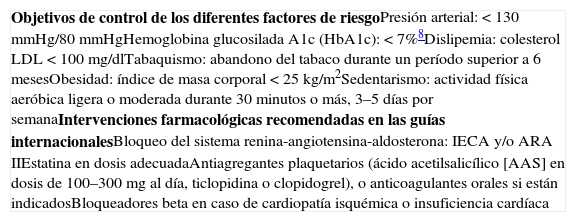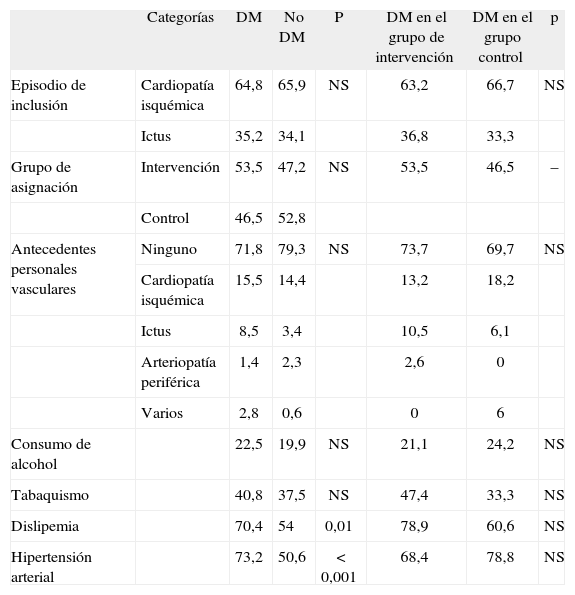El control de los factores de riesgo cardiovascular (FRCV) en prevención secundaria adquiere gran importancia en los diabéticos, aunque suele ser aún más difícil de alcanzar que en los no diabéticos. En este artículo se compara el grado de control de los FRCV y los tratamientos pautados en los pacientes diabéticos frente a los no diabéticos del estudio MIRVAS, así como la influencia de una intervención intensiva y multifactorial sobre ambas variables en esta población.
Material y métodosSe comparan los subgrupos de diabéticos (71: 38 del grupo intervención y 33 del grupo control) entre sí y con el de no diabéticos (176: 83 y 93 respectivamente) del estudio MIRVAS. Los objetivos de control de los FRCV y los tratamientos a pautar son los recomendados en las guías internacionales.
ResultadosEn los diabéticos la prevalencia basal de la hipertensión arterial (HTA) y de la dislipemia es superior (70,4% frente al 54% y 73,2% frente al 50,6%, respectivamente). Al año, la presión arterial (PA) y el colesterol HDL son significativamente peores en los pacientes diabéticos (45,9% con una PA controlada en los diabéticos frente a un 81,9% en los no diabéticos; 49,43 mg/dl en diabéticos frente a 53,82 mg/dl en no diabéticos). Los diabéticos del grupo intervención presentan al año mejores cifras de HbA1c (5,52% frente a 6,59%), colesterol HDL (52,81mg/dl frente a 45,24mg/dl) y PA sistólica (123,03mmHg frente a 136,50mmHg) y de prescripción de estatinas (96,77% frente a 76,67%).
DiscusiónAunque la presencia de diabetes dificulta el logro de los objetivos de control en prevención secundaria, una intervención intensiva y multifactorial como la realizada en el estudio MIRVAS puede obtener mejores resultados.
Control of cardiovascular risk factors (CVRF) in secondary prevention becomes very important in diabetic patients, although this can be even more difficult to achieve than in non-diabetic patients. This article compares the degree of control of CVRF and drugs prescribed to diabetics versus non-diabetics in the MIRVAS study. It also evaluates the results of an intensive and multifactorial intervention regarding both subjects in this population.
Material and methodsThe subgroups of diabetic patients are compared (71 patients: 38 in the intervention group and 33 in the control group) within groups and with the non-diabetics (176 patients: 83 and 93, respectively), all of them included in the MIRVAS study. The targets of CVRF control and drugs to be prescribed are those recommended in the international guidelines.
ResultsThe baseline prevalence of high blood pressure and dyslipidemia is higher in diabetic patients (70.4% vs. 54% and 73.2% vs. 50.6%, respectively). At one year after the cardiovascular event, blood pressure (BP) and HDL-cholesterol control are significantly worse in diabetics (45.9% of diabetic patients vs. 81.9% of non-diabetics with BP under control; 49.43 mg/dl in diabetics vs 53.82 mg/dl in non-diabetics). Diabetics from the intervention group have better HbA1c (5.52% vs. 6.59%), HDL-cholesterol (52.81mg/dl vs. 45.24mg/dl), systolic BP (123.03mmHg vs. 136.50mmHg) and statins prescription (96.77% vs. 76.67%).
ConclusionsDiabetes mellitus makes it more difficult to achieve the objectives of control in secondary prevention. An intensive and multifactorial intervention such as that one done in MIRVAS study can attain better results.
Artículo
Diríjase desde aquí a la web de la >>>FESEMI<<< e inicie sesión mediante el formulario que se encuentra en la barra superior, pulsando sobre el candado.

Una vez autentificado, en la misma web de FESEMI, en el menú superior, elija la opción deseada.

>>>FESEMI<<<












